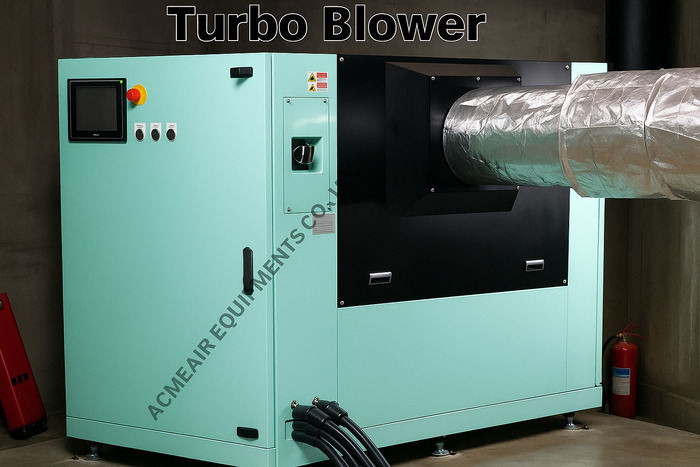Table of Contents
As the world shifts toward more sustainable energy solutions, green hydrogen is emerging as a key player in decarbonizing industries that are traditionally difficult to electrify, such as heavy transport and industrial manufacturing. At the heart of these green hydrogen production plants lies essential equipment like turbo blowers, which play a pivotal role in optimizing the processes involved in hydrogen production.
Turbo blowers, are shaping the future of green hydrogen production by improving efficiency, reducing energy consumption and enabling large-scale production with minimal environmental impact. This article explores how turbo blowers are transforming the hydrogen production process and driving the growth of green hydrogen as a reliable energy source.
What Role Do Turbo Blowers Play in Green Hydrogen Production?
Turbo blowers are designed to provide high-pressure, high-flow air to various processes within industrial applications, including green hydrogen production. In electrolysis plants – where water is split into hydrogen and oxygen using electricity – turbo blowers are used to supply the necessary airflow for the cooling and pressurization of electrolysis cells. The role of turbo blowers in this process cannot be overstated, as they ensure that the system operates efficiently and at the desired pressure levels.

In a typical electrolysis plant, high-speed turbo blowers provide the air or gas required for the electrochemical reactions that take place. The constant airflow from turbo blowers ensures that the system remains stable, allowing for consistent hydrogen production. With their efficiency and reliability, turbo blowers play an integral part in reducing the overall energy consumption of these plants.
How Do Turbo Blowers Improve Efficiency in Green Hydrogen Production?
The integration of energy-efficient turbo blowers into green hydrogen production plants offers significant improvements in overall plant efficiency. This efficiency is achieved in several ways:
Energy Savings and Reduced Operational Costs
Energy-efficient turbo blowers consume less electricity while providing the same – or even better – performance compared to traditional blowers. This is particularly crucial in green hydrogen production, where minimizing energy consumption is key to ensuring the cost-effectiveness of hydrogen production. By optimizing the airflow and pressure requirements, turbo blowers reduce the amount of energy needed to operate the system, lowering both operational costs and the plant’s environmental impact.
Hydrogen production is an energy-intensive process and the integration of high speed turbo blowers makes it possible to achieve greater production levels with less energy input, contributing to a more sustainable operation.
High-Pressure, Stable Air Supply
Turbo blowers are designed to operate at high speeds, providing a steady, high-pressure airflow essential for the electrolysis process. In a green hydrogen production plant, where the electrolysis process requires consistent and stable airflow, turbo blowers ensure that the reaction cells maintain the correct pressure for efficient hydrogen production. This stability prevents interruptions or fluctuations in production, making it possible to achieve higher yields without compromising efficiency.
Reduced Maintenance and Downtime
Another advantage of turbo blowers is their reliability and durability. These blowers are designed to handle the rigorous demands of industrial applications and require less maintenance compared to traditional blowers. In the context of green hydrogen production, this translates to fewer disruptions, lower repair costs and less downtime for the production system. By ensuring that the blowers operate smoothly for longer periods, the overall uptime of the hydrogen production plant increases, leading to greater efficiency.
What Benefits Do Turbo Blowers Offer for Scalability in Hydrogen Production?
As the demand for green hydrogen increases, hydrogen production plants are being built on a larger scale. Turbo blowers play an essential role in the scalability of these plants due to their capacity to provide consistent, high-pressure airflow in systems that are expanding rapidly.
Adaptability to High-Volume Hydrogen Production
As hydrogen production plants grow to meet the increasing demand for green hydrogen, they require equipment that can handle large volumes of gases and materials efficiently. Turbo blowers are capable of managing high volumes of air and gas at varying pressures, making them ideal for large-scale operations. Their design ensures that they can handle the additional airflow and pressure demands without a drop in efficiency.
This adaptability allows Energy Efficient Turbo Blowers to be integrated into various stages of hydrogen production, from small pilot plants to large commercial-scale facilities, facilitating the transition to mass production.
Flexibility in Application
Turbo blowers can be customized to meet the specific needs of different hydrogen production facilities. Depending on the plant’s size, hydrogen output and operational requirements, high-speed turbo blowers can be adjusted for optimal performance. This flexibility means that as hydrogen production systems expand or evolve, the turbo blowers can be reconfigured or upgraded to match new demands, ensuring that scalability is never compromised.
Where Turbo Blowers Are Integrated into Green Hydrogen Production Plants?
Turbo blowers are integrated into several key processes in green hydrogen production plants, particularly in areas where high-pressure air or gas is required. These areas include:
Electrolysis Cells
Turbo blowers are essential in maintaining the airflow in the electrolysis cells, where water is split into hydrogen and oxygen using electricity. The high-speed turbo blowers provide the necessary pressure to drive the electrolysis reaction, ensuring that the process is carried out efficiently. The continuous flow of air generated by the blowers prevents backpressure and allows for consistent production rates.
Hydrogen Compression and Storage
Once hydrogen is produced through electrolysis, it needs to be compressed for storage and transport. Turbo blowers are used to pressurize hydrogen gas, making it possible to store large amounts of hydrogen at high pressure in storage tanks. The efficiency and reliability of energy efficient turbo blowers ensure that the compression process is optimized, minimizing energy usage while maintaining safe and effective storage conditions.
Cooling Systems
During the production of green hydrogen, excess heat is generated that must be managed to maintain optimal operating conditions. Turbo blowers are used in cooling systems to provide airflow for heat dissipation. By maintaining a stable temperature within the plant, these blowers help ensure that the electrolysis process runs smoothly and that equipment remains within safe temperature ranges.
When Should Hydrogen Production Plants Invest in Turbo Blowers?
The integration of turbo blowers is not only beneficial but often essential for modern green hydrogen production plants. Businesses should consider investing in turbo blowers when:
Expanding Hydrogen Production Capacity
As hydrogen production plants grow and increase their output to meet the rising demand for green hydrogen, turbo blowers provide the scalability needed to handle higher production volumes efficiently. The ability to meet increased production requirements while maintaining energy efficiency is a key factor in deciding to invest in turbo blowers.
Upgrading to Energy-Efficient Systems
For plants aiming to reduce operational costs and improve sustainability, upgrading to High Speed Turbo Blowers can lead to substantial savings. These blowers provide the same or better performance while consuming less power, making them an ideal investment for plants looking to optimize their energy usage.
Reducing Operational Downtime
Given the importance of minimizing downtime in hydrogen production, turbo blowers can be a critical investment. Their long lifespan, reliability and low maintenance requirements ensure that operations can run without interruptions, contributing to higher overall efficiency.
Conclusion
The integration of turbo blowers into green hydrogen production plants is a crucial development in the drive toward more efficient and sustainable hydrogen production. These blowers improve efficiency by providing high-pressure airflow, reducing energy consumption and enhancing the scalability of production. As the demand for green hydrogen continues to grow, turbo blowers will play an even more significant role in shaping the future of hydrogen production, enabling the industry to meet global energy needs while minimizing environmental impact.
FAQs About Turbo Blowers
What is a Turbo Blower and how does it work in green hydrogen production?
A Turbo Blower is a high-speed air-moving device used to provide continuous, high-pressure airflow in industrial applications. In green hydrogen production, turbo blowers are used in electrolysis cells to ensure stable airflow, which is crucial for the efficient production of hydrogen.
How do Turbo Blowers improve energy efficiency in hydrogen production?
Energy-efficient turbo blowers consume less electricity while providing the same or higher performance, leading to reduced energy consumption in hydrogen production plants and lowering operational costs.
Why are Turbo Blowers important for scaling up hydrogen production?
Turbo blowers provide the necessary high-pressure airflow for large-scale hydrogen production facilities. They are adaptable and scalable, capable of handling increased production volumes without compromising efficiency or performance.
When should a hydrogen production plant invest in Turbo Blowers?
Hydrogen production plants should invest in turbo blowers when expanding production capacity, upgrading to more energy-efficient systems or seeking to reduce operational downtime by minimizing maintenance and enhancing reliability.
What are the benefits of using Turbo Blowers in hydrogen compression and storage?
Turbo blowers are used in hydrogen compression to ensure efficient pressurization for storage and transport. Their energy efficiency and reliability contribute to safe, cost-effective hydrogen storage.
About Author

CEO
Mr. Vishwesh Pardeshi is the CEO of Acme Air Equipments Company Pvt. Ltd., an industrial and engineering goods manufacturing company based in Ahmedabad, Gujarat (India). He has taken over the responsibility from founding Partners and Directors of the Company, and is now leading a talented group of professionals since 2020 by bringing in vast industrial and management expertise. By qualification, he holds a Bachelor Degree in Mechanical Engineering and also holds a MBA degree from reputed institutes. Under his leadership, the Company has successfully executed prestigious projects by delivering high quality and world class products from a state of the art manufacturing facility which combines CNC-enabled precision manufacturing and strong after sales support. In line with the Vision, Mission and Core Values of the Organization, Mr. Vishwesh Pardeshi continues to drive Quality, Reliability and Global Expansion at Acme Air Equipments Co. Pvt. Ltd.









